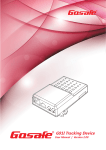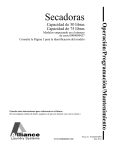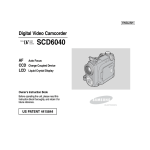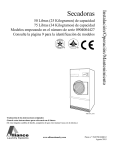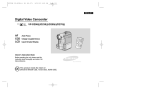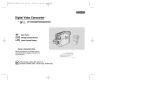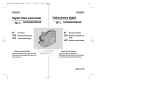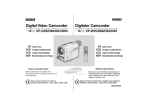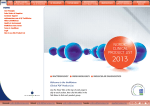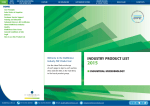Download Samsung VP-D6050(i) Camcorder User Manual
Transcript
∞£¥‹º≥∏̺≠ (D6050) 11/19/04 8:42 AM Page 1 Digital Video Camcorder VP-D6050(i)/D6050S(i) VP-D6040(i)/D6040S(i) Features .....................................................2 Notes and Safety Instructions....................3 Getting to Know Your Camcorder ..........4 Miscellaneous Information......................7 Basic Recording............................................8 Maintenance .......................................9 * Samsung Electronics’ Internet Home Page United Kingdom http://www.samsungelectronics.co.uk Troubleshooting ................................10 ∞£¥‹º≥∏̺≠ (D6050) 11/19/04 8:42 AM Page 2 Features Supports IEEE 1394 Digital Data Transfer By incorporating the IEEE 1394 (i.LINKTM: i.LINK is a serial data transfer protocol and inter-connectivity system, used to transmit DV data) high speed data transport port, both moving and still images can be transferred to a PC, making it possible to produce or edit various images. Integrated Camcorder/DSC operation An integrated digital imaging device that easily converts between a Digital Camcorder and a Digital Still Camera with a flip of the Power Switch, ensuring comfortable and easy recording. High Resolution Image Quality (Digital Still Camera) Employing 4 Mega Pixels CCD, a maximum resolution of 2272x1704 is available (VP-D6040(i)/D6040S(i) only). Employing 5 Mega Pixels CCD, a maximum resolution of 2592x1944 is available (VP-D6050(i)/D6050S(i) only). Digital Zoom Allows the user to magnify an image up to 900x (Camcorder Mode) or 12x (Camera Mode) its original size. Colour TFT LCD A high-resolution colour TFT LCD gives you clean, sharp images as well as the ability to review your recordings immediately. Various Digital Effects The DSE (Digital Special Effects) allows the user to give the film a special look by adding various special effects. MULTI OSD LANGUAGE You can select the desired OSD Language among English, French, German, Spanish, and Italian. Various Scene Modes The SCENE modes enable you to easily alternate the shutter speed and aperture settings to suit the type of scene/action being filmed. NIGHT CAPTURE The NIGHT CAPTURE function enables you to record a subject in a dark place. USB Interface for Digital Image Data Transfer You can transfer still images to a PC using the USB interface without an add-on card. Supports Various Memory Card Types Multimedia Card (MMC), Secure Digital Memory Card (SD Card), Memory Stick, and Memory Stick Pro memory cards are supported. Supports DPOF & PictBridge Printing Aid Digital Image Stabiliser (DIS) The DIS compensates for any natural shaking movements, reducing unstable images, particularly at high magnification. DPOF (Digital Printing Order Format) and PictBridge interfaces are supported. By using these features, you can print your still images by using a printer that supports these features without having to use your PC. 2 ∞£¥‹º≥∏̺≠ (D6050) 11/19/04 8:42 AM Page 3 Notes and Safety Instructions Notices Regarding COPYRIGHT ✤ Television programmes, movie video tapes, DVD titles, films and other programme materials may be copyrighted. Unauthorised recording of copyrighted materials may infringe on the rights of the Copyright owners and is contrary to copyright laws. ✤ All the trade names and registered trademarks mentioned in this manual or other documentation provided with your Samsung product are trademarks or registered trademarks of their respective holders. Notes Regarding Moisture Condensation 1. A sudden rise in atmospheric temperature may cause condensation to form inside the camcorder. For Example: ✤ Entering or leaving a heated place on a cold day might cause condensation inside the product. ✤ To prevent condensation, place the product in a carrying case or a plastic bag before exposing it to a sudden change in temperature. 2. If the (DEW) protection feature is activated, leave the camcorder for at least two hours in a dry, warm room with the cassette compartment opened and the battery removed. Notes Regarding the CAMCORDER 1. Do not leave the camcorder exposed to high temperature (above 60°C or 140°F). For example, in a parked closed car in summer or exposed to direct sunlight. 2. Do not let the camcorder get wet. Keep the camcorder away from rain, salt water, or any other form of moisture. The product will be damaged if immersed in water or subjected to high levels of moisture. Notes Regarding the Battery Pack ✤ Make sure the battery pack is fully charged before starting to record. ✤ To preserve battery power, keep your camcorder turned off when you are not operating it. ✤ If your device is in Camcorder mode, and it is left in STBY mode without being operated for more than 5 minutes with a tape loaded, it will automatically turn itself off to protect against unnecessary battery discharge. ✤ Make sure that the battery pack is attached firmly in place. ✤ The new battery pack provided with the product is not charged. Before using the battery pack, you need to fully charge it. ✤ Do not drop the battery pack. Dropping the battery pack may damage it. ✤ It is a good idea to use the viewfinder rather than the LCD monitor when recording for long periods, because the LCD monitor consumes more battery power. ✤ Fully discharging a Lithium-Ion battery damages the internal cells. The battery pack may be prone to leakage when fully discharged. ✤ To avoid damage to the battery pack, make sure to remove the battery when no charge remains. Notes Regarding the Battery Pack ✳ When the battery reaches the end of its life, please contact your local dealer. Batteries must be disposed of as chemical waste. ✳ Be careful not to drop the battery pack when you release it from the camcorder. Notes Regarding Video Head Cleaning ✤ To ensure normal recording and a clear picture, clean the video heads regularly. If a square block-shaped distorts playback, or only a blue screen is displayed, the video heads may be dirty. If this happens, clean the video heads with a dry type cleaning cassette. ✤ Do not use a wet-type cleaning cassette. It may damage the video heads. Notes Regarding the Lens ✤ Do not film with the camera lens pointing directly at the sun. Direct sunlight can damage the CCD (Charge Coupled Device, the imaging sensor). Notes Regarding the Electronic Viewfinder 1. Do not position the camcorder such that the viewfinder is pointing directly towards the sun. Direct sunlight can damage the inside of the viewfinder. Be careful when setting the camcorder in a sunny place or near a window exposed to sunlight. 2. Do not pick up the camcorder by holding the viewfinder. 3. Applying excessive force to the viewfinder may damage it. Notes Regarding ‘Record’ or ‘Playback’ Using the LCD 1. The LCD monitor has been manufactured using the high precision technology. However, there may be tiny dots (red, blue or green in colour) that appear on the LCD monitor. These dots are normal and do not affect the recorded picture in any way. 2. When you use the LCD monitor under direct sunlight or outdoors, it maybe difficult to see the picture clearly. If this occurs, we recommend using the viewfinder. 3. Direct sunlight can damage the LCD monitor. Notes Regarding the Hand Strap ✤ To ensure a steady picture during filming, make sure that the hand strap is properly adjusted. ✤ Do not force your hand into the hand strap as you could damage it. 3 ∞£¥‹º≥∏̺≠ (D6050) 11/19/04 8:42 AM Page 4 Getting to Know Your Camcorder Front & Left View 6. Camera Mode Dial 7. Display Button 8. 5-way Button 1. Built-in MIC 2. Built-in Flash 9. Menu Button 10. EasyQ Button 11. LCD Open 3. Camcorder Lens 12. Remote Signal Receiver 13. Charge Indicator 4. Camera Lens 14. Navigation Wheel (Quick Menu / Focus / Volume) 5. Focus Button MF/AF 1. Built-in MIC 2. Built-in Flash 3. Camcorder Lens 4. Camera Lens 5. Focus Button MF/AF 6. Mode Dial for Camera 7. Display Button 8. 5-way Button 9. Menu Button 10. EasyQ Button 11. LCD Open 12. Remote Signal Receiver 13. Charge Indicator 14. Navigation Wheel (Quick Menu/Focus/Volume) Accessories Supplied with the Camcorder Make sure that the following basic accessories are supplied with your digital video camera. 1. Lithium Ion Battery pack 2. AC Power Adapter (AA-E8 Type) 3. AC Power Cord 4. Multi-AV Cable 5. Instruction Book 6. Lithium battery for Remote Control and Clock (CR2025 type, 2EA) 7. Shoulder Strap 8. USB Cable 9. Software CD 10. Remote Control 11. Memory Stick 12. Lens Cover Basic Accessories 1. Lithium Ion Battery Pack 2. AC Power Adapter 3. AC Power Cord 4. Multi-AV Cable 5. Instruction Book 6. Lithium battery for Remote Control and Clock 7. Shoulder Strap 8. USB Cable 9. Software CD 10. Remote Control 11. Memory Stick 12. Lens Cover Optional Accessory 13. Scart adapter (Option) 13. Scart Adapter 4 ∞£¥‹º≥∏̺≠ (D6050) 11/19/04 8:42 AM Page 5 Getting to Know Your Camcorder Rear & Left View 1. 1. PLAY/STILL (FADE) 2. 4. STOP (BLC) 3. REW Multiple Display 5. Delete 6. FF 7. Built-in Speaker 8. USB Cable Jack 9. DV Cable Jack 10. Multi-AV Cable Jack 11. DC Power in Jack PLAY/STILL (FADE) 9. DV Cable Jack 2. STOP (BLC) 10. Multi-AV Cable Jack 3. REW 11. DC Power in Jack 4. Multiple Display 5. Delete 6. FF 12. Viewfinder 13. Battery Release 12. Viewfinder 7. Built-in Speaker 8. USB Cable Jack 13. Battery Release Rear & Right View 6. SLOW SHUTTER 1. PHOTO 2. FOCUS ADJUST 3. Power Switch 4. START/STOP 7. NIGHT CAPTURE 8. ZOOM LEVER 9. External MIC input jack 10. Memory Card Slot 11. Hand Strap 5. Hand Strap Ring 1. PHOTO 2. FOCUS ADJUST 3. Power Switch 4. START/STOP 5. Hand Strap Ring 6. SLOW SHUTTER 7. NIGHT CAPTURE 8. ZOOM LEVER 9. External MIC input jack 10. Memory Card Slot 11. Hand Strap Memory Card slot Memory Stick Memory Stick PRO SD/MMC (Usable MEMORY CARDs) 5 ∞£¥‹º≥∏̺≠ (D6050) 11/19/04 8:42 AM Page 6 Getting to Know Your Camcorder Rear & Bottom View 1. Shoulder Strap Hook 3. Tripod Receptacle 1. Shoulder Strap Hook 2. Battery Release 3. Tripod Receptacle 4. Tape Eject Slide Button 4. Tape Eject Slide Button 5. Lithium Battery Holder 2. Battery Release 5. Lithium Battery Holder 6. Hand Strap Ring 7. Hand Strap Hook 6. Hand Strap Ring 7. Hand Strap Hook Remote Control 1. PHOTO 2. START/STOP 3. SELF TIMER 4. ZERO MEMORY 5. PHOTO SEARCH 6. A.DUB 7. (FF) 8. (REW) 9. (PLAY) 10. DIRECTION( , ) 18. DISPLAY 17. ZOOM 16. X2 15. DATE/TIME 14. (SLOW) 13. (STILL) 12. (STOP) 11. F.ADV 1. PHOTO 13. (STILL) 2. START/STOP 14. (SLOW) 3. SELF TIMER 15. DATE/TIME 4. ZERO MEMORY 16. X2 5. PHOTO SEARCH 17. ZOOM 6. A.DUB 18. DISPLAY 7. (FF) 8. (REW) 9. (PLAY) 10. DIRECTION ( , ) 11. F.ADV 12. (STOP) 6 ∞£¥‹º≥∏̺≠ (D6050) 11/19/04 8:42 AM Page 7 Miscellaneous Information Connecting to Other Devices – TV and VCR ✤ You can connect your device to a TV set directly or through a VCR to view your recordings and pictures on the TV screen, using the Multi-AV cable. ✤ You can connect your device to a PC to copy or move your recordings and pictures to the hard disk drive, using the USB cable or the DV cable. ✤ You can connect your device to other DV-enabled devices using the DV cable. Connecting to a TV Set Through a VCR ✤ If there are no input terminals for external devices on your TV set and a VCR is connected to your TV set using a coaxial cable, you can utilize the VCR to connect your camcorder to the TV set. ■ To Connect to a VCR that is Connected to Your TV Set ■ To Connect to a TV set 1. Connect the Multi-AV cable to your camcorder’s multi-AV jack. 1. Connect the Multi-AV cable to your camcorder’s multi-AV jack. VCR Video input (Y) Audio input (L) Audio input (R) 2. Connect the Multi-AV cable to the external input terminal of your TV set by matching the colours of the terminals. 2. Connect the Multi-AV cable to the External Inputs (LINE-IN) on the VCR by matching the colours of the terminals. TV MULTI-AV ANTENNA 3. Connect the TV and VCR using the coaxial cable. Refer to the Video or TV’s instruction book for further connection details. ■ To Play Back Recorded Video 1. Turn your TV on and select the external input source connected to your camcorder. Video inputYellow TV 2. Locate the desired position on the tape using the (REW) or (FF) button. 3. Press the (PLAY/STILL) button of the camcorder to start playback. 4. To stop the playback, press the CAMCORDER S-VIDEO input Audio input (left)-White Audio input (right)-Red Camcorder 4. Set the input source of the VCR to the external input source connected to your camcorder. S-VIDEO input ■ To Play Back Recorded Video MULTI-AV (STOP) button. 1. Turn your TV on and select the external input source that is connected to the VCR. Set the TV channel to view the VCR. 3 or 4 is most often used. 2. Locate the desired position on the tape using the 3. Press the Reference ✤ Some TV sets have LINE-IN input terminals instead of External Input terminals. Refer to the manufacturer’s instructions for detailed information on connecting external devices. ✤ If a TV set has an S-VIDEO input terminal, you may use S-VIDEO for better quality. ✤ If you use an S-VIDEO cable, you will need to connect an audio cable. ✤ If only a mono audio input is available on the TV set, use the audio cable with the white plug. (REW) or (FF) button. (PLAY/STILL) button of the camcorder to start playback. 4. To stop the playback, press the (STOP) button. Reference ✤ If the VCR has an S-VIDEO input terminal, you may use S-VIDEO for better quality. ✤ The S-VIDEO terminal transmits video only. Connect AUDIO cables for sound. ✤ If only a mono audio input is available on the TV set, use the audio cable with the white plug. 7 ∞£¥‹º≥∏̺≠ (D6050) 11/19/04 8:42 AM Page 8 Basic Recording Making your First Recording Recording Playing Back a Tape You Have Recorded Using the LCD Monitor 1 Before you begin! - Insert the Lithium Ion Battery (refer to page 28) - Charge your battery (refer to page 28) - Set the Clock (refer to page 38) - Insert a cassette tape (refer to page 47) 1. Turn on your camcorder and set the Power Switch to REC mode. ✤ You can monitor the recorded image on the LCD monitor. 1. Turn on your camcorder and set the Power Switch to PLAY mode. 2. Insert the tape you want to playback (refer to page 47). 2 3. Open the LCD monitor and adjust the angle of the screen. Adjust the LCD Brightness or Colour if necessary (refer to page 33). 4. Press the (REW) button to rewind the tape to the desired viewing point. To stop rewinding, press the (STOP) button. The camcorder will automatically stop rewinding when the tape is fully rewound. 2. Open the LCD or viewfinder and frame your subject on the screen. 3. To Start recording, press the START/STOP button. ■ The REC indicator is displayed on LCD. 3 4. To Stop recording, press the START/STOP button again. ■ The STBY indicator is displayed on LCD. 5. Press the (PLAY/STILL) button to start the playback. You can view the recording on the LCD. To stop the playback, press the (STOP) button. Reference ✤ If the Write Protection Tab on the cassette tape is set to protect, the “PROTECTION!” message appears on the screen. Release the Write Protection Tab to record. ✤ Detach the Battery Pack when you finished recording to prevent unnecessary battery power consumption. When a cassette is loaded and the camcorder is left in STBY under REC mode for more than 5 minutes without being used, it will switch off automatically. To resume the camcorder, press the START/STOP button or set the Power Switch to off shortly and then set it back to REC mode. This Auto Power Cut feature is designed to save the battery power. Reference ✤ You can also view the recording on a TV screen, by connecting the camcorder to a TV or VCR (refer to page 145). ✤ For searching and viewing still images recorded onto tape, refer to page 76. ✤ Various functions are available in PLAY mode (refer to page 74). Record Search (REC SEARCH) ✤ You can view a recording using the REC SEARCH +, – function while in STBY mode. ■ REC SEARCH – enables you to play the recording backwards and ■ REC SEARCH + enables you to play it forwards, for as long as you keep either button pressed down. ✤ If you press the REC SEARCH – button just once while in STBY mode, your camcorder will play in reverse for 3 seconds and then automatically return to the original position. Reference ✤ Mosaic shaped distortion may appear on the screen while in Record Search mode. 8 ∞£¥‹º≥∏̺≠ (D6050) 11/19/04 8:42 AM Page 9 Maintenance Cleaning and Maintaining the Camcorder ✤ For prolonged use of your device, read following instructions carefully. After Using Your Camcorder ■ ✓ ✓ ✓ ✓ For the safekeeping of your device, follow these steps. Remove the cassette (refer to page 47). Turn your camcorder off. Remove the Battery (refer to page 28). Remove the Memory Card (refer to page 83) ■ To prevent any damage to the LCD monitor, do not apply excessive force on its moving parts. ■ Do not drop or in anyway shock the device. ■ For prolonged use of your device, avoid using it in places subject to excessive humidity or dust. ■ Do not leave your device in places subject to: ✓ Excessive humidity, steam, soot or dust ✓ Excessive shock or vibration. ✓ Extremely high (over 50°C or 122°F) or extremely low (under 0°C or 32°F) temperatures. ✓ Strong electromagnetic fields. ✓ Direct sunlight or in a closed car on a hot day. ■ The cassette should be stored away from heaters and other heat sources. Avoid storing cassettes under direct sunlight, and avoid electromagnetic fields. ■ The removed Battery Packs should be stored away from heaters and other heat sources. Do not store the battery pack with metal objects or sharp objects to avoid accidental damage to the battery pack. ■ The memory card should be stored away from heaters and other heat sources. Avoid storing memory cards under direct sunlight, and avoid electromagnetic fields. Before removing the memory card from your device, move or copy your data from the memory card to a PC. Format the memory card periodically. Cleaning the Camera Body and Video Heads ■ To Clean the Exterior of Your Device ✓ To clean the exterior, use a soft dry cloth. Wipe the body gently. Do not apply excessive force when cleaning, gently rub the surface. ✓ The LCD monitor surface should not be pressed. Use a soft dry cloth to clean the surface. ✓ To clean the lens, use an optional air blower to blow out dirt and other small objects. Do not wipe the lens with cloths or your fingers. If necessary, use lens cleaning paper. ✓ Do not use chemicals, alcohol or benzene for cleaning. Otherwise, the finish may be damaged. ✓ Cleaning should be done only after the battery pack has been removed, and other power sources have been disconnected. ■ To Clean the Video Heads ✓ Dirty heads might cause problems with noisy recording and playback. ✓ To ensure normal operation of the video heads, avoid using in (blue screen) places subject to heavy dust. ✓ Avoid excessively frequent fast forwarding and rewinding of cassettes to avoid damaging the video heads. ✓ Excessive use of a cleaning cassette is not recommended. ✓ Use an optional cleaning cassette for video head cleaning. Periodic check-ups are recommended. 1. Load the Cleaning Cassette. 2. Set the Power Switch to PLAY mode. 3. Press the (PLAY/STILL) button to start cleaning. 4. Stop playing after 10 ~ 20 seconds. Reference ✤ Some cleaning cassette products stop automatically. Refer to the cleaning cassette’s instructions for detailed information. If the problem continues after the cleaning, consult your nearest Samsung dealer or Authorised Service Centre. ✤ Do not use wet-type cleaning cassettes. 9 ∞£¥‹º≥∏̺≠ (D6050) 11/19/04 8:42 AM Page 10 Troubleshooting Troubleshooting ✤ If your device fails to function as expected, please check the following before contacting service personnel. Refer to the page numbers listed for further details. Self Diagnosis Display Display Informs that… Blinking Slow The battery pack is almost discharged TAPE END! Slow TAPE END! Action Change to a charged one or connect to other power source When the remaining time on the tape is less than 2 minutes Prepare a new cassette No Cassette has reached its end Change to a new cassette TAPE! Slow No cassette tape is inserted Insert a tape PROTECTION! Slow The tape is Record Protected Change to a new cassette or release the tape record protection D,L,C,R Slow Camcorder has a mechanical fault 1. Eject the cassette tape. 2. Set to off 3. Detach the battery. 4. Restart the camcorder If problem continues, contact your local service representative. Slow Moisture condensation See page 11 NO CARD! Slow No memory card is inserted Insert a memory card CARD FULL! Slow Not enough space for saving pictures Change to a new memory card or delete recorded images NO IMAGE! Slow There are no images recorded to play Record a new still image Delete the image or format the memory card FILE ERROR! Slow The image file has an error CARD ERROR! Slow Memory card is formatted by other Format the memory card using the camera menu device or has error in system folder ✤ If these instructions do not solve your problem, contact your nearest Samsung dealer or authorised service center/personnel. Possible Causes Measure The power is not connected properly The battery is dead The battery is too cold Connect the AC adapter properly, page 27 Replace the dead battery pack Warm up the battery or move to warmer place Viewfinder is on. Multi-AV cable is connected Display option is turned off Close the viewfinder Remove the cable Press the DISPLAY button to bring back OSD DATE/TIME is wrong The DATE/TIME is not set The built-in clock battery has exhausted. Set the DATE/TIME, page 38 Replace the Li-ion battery for built-in clock, page 24 Cannot Record a video Protection tab is set to “SAVE” Cancel the protection, page 48 Power Switch is set to PLAY Set the Power Switch to REC Power Switch is set to (CAMERA) Set the Mode Dial to (MOVIE) mode Symptom No power is supplied LCD monitor is blank Symptom Possible Causes Measure Focus does not adjust automatically Focus is set to manual mode Recording was done in a dark place Lens is covered with condensation Set focus to AUTO Use strobe or lit the place Clear the lens and check the focus Cassette tape will not load properly Cassette is in wrong position The battery is exhausted Insert the cassette tape properly, page 47 Charge the battery or use AC adapter The memory card will not load properly Insert the memory card properly, page 83 Memory card is in wrong position Something fills in the memory card slot Clear the memory card slot Colour balance of picture is not White balance adjustment is required natural Set proper white balance, page 121 Digital zoom does not work Turn off the digital special effects. page 57 Digital special effect is applied Files stored in the memory card Memory card is protected cannot be deleted File is protected Remove the protection tab of memory card Remove the protection on the file, page 135 Images on the LCD monitor appear dark Adjust the brightness and angle of LCD Low temperatures might produce a dark LCD display This is not a malfunction. Ambient is too bright Ambient temperature is too low Rear of the LCD monitor is hot Prolonged use of LCD monitor Close the LCD monitor to turn if off, or turn your device off to cool down. Play, rewind and fast forwarding do not work Set the Power Switch to PLAY Power Switch is set to REC Memory card cannot be played Power Switch is set to PLAY Mode back (Camera mode) Set the Power Switch to (CAMERA) Mode and set the Mode Dial to (PLAY) Mode No picture is taken when PHOTO is fully pressed Not enough free memory space is remained Memory card is formatted by different devices Delete files from the memory card Flash is forced to cancel Focus is set to infinity AE lock is enabled Taking the motion clips Continuous shot option is turned on Bracket shooting is enabled Blocking the flash lid Select different flash mode, page 110 Select AUTO, EASYQ, or different MF distance, page 112 Turn off the AE lock Flash is not available for Motion clips Turn off the continuous shot Turn off the AEB, page 125 Clear obstructing object Built-in flash will not pop up or fire Format the memory card 10










